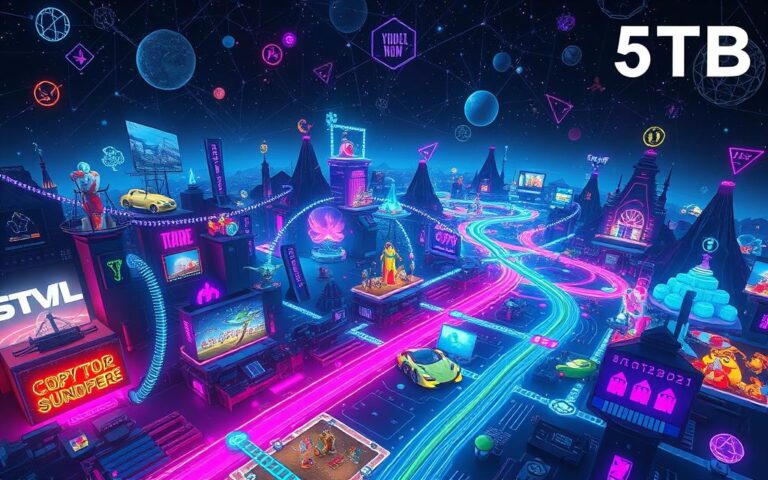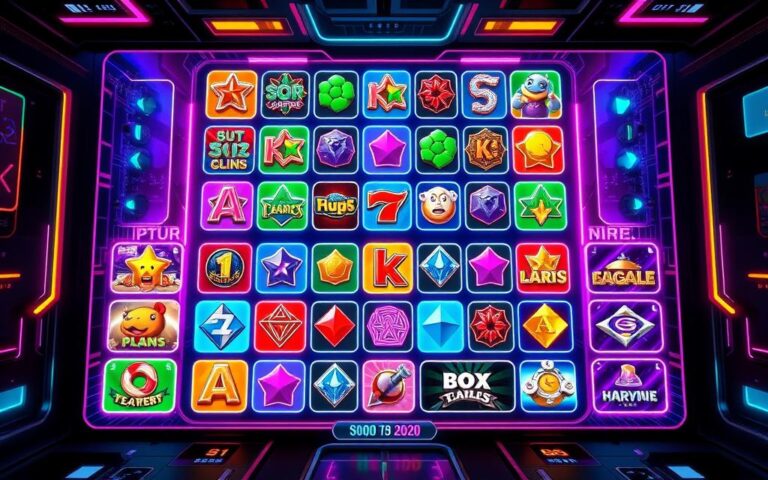How to Make Your Own Hyper Casual Games
Hyper casual games are a big deal in mobile gaming today. They attract players with their easy-to-learn gameplay. If you dream of making games or love game development, this guide is for you. We’ll show you how to create games that people love to play. You’ll learn about game design basics and how to earn money from your game.
We’ll go through 66 essential steps to make your game engaging. You’ll learn to pick the best game mechanics and keep your game simple. We’ll also discuss how to make money through ads. Games like Tetris and Candy Crush show what you can achieve. They prove making games can be a rewarding path for mobile gaming fans.
Understanding Hyper Casual Games
Hyper casual games have changed the gaming scene by being easy to get into. They’re known for simple rules, which many people like. This has helped them become more popular and their market grow.
Definition and Characteristics
Hyper casual games are simple yet engaging. Players can start playing quickly without needing long instructions. Features of these games include:
- Fast-paced gameplay that encourages quick choices.
- Minimalistic design focusing on simplicity.
- Instant gratification, making players come back.
These games have become big business, worth US$1.5 billion in 2021 and expected to grow. Hits like Helix Jump, with 800 million downloads, show just how popular they are.
Popular Features of Hyper Casual Games
Top hyper casual games share certain traits that make them fun. These include:
- High score tracking for player rivalry.
- Simple touch or swipe controls that anyone can use.
- Visually satisfying feedback to reward players.
Mobile game trends show that hyper casual games top the download charts. Over 35 million downloads were recorded in the last quarter of 2023. With a focus on simple fun, they attract a wide audience.
Identifying Your Target Audience
Knowing your target audience is key for successful hyper-casual games. These games attract many players from different backgrounds. By understanding what these players like, you can get more people to download your games.
Mass Market Appeal
How appealing a hyper-casual game is depends a lot on how easy it is to get into. A large number of people play mobile games. For instance, in the US, 32.7% of mobile gamers are aged 25 to 34. This group has its own gaming habits and likes.
Also, 42.3% of people who play mobile games are women. This shows how important it is to include everyone in game design. It helps to reach a wider audience.
The Importance of Recognisable Themes
Using familiar themes in games helps connect with players better. Themes like animals or daily life activities appeal to many. This connection makes players more invested in the game.
Hyper-casual games have been downloaded 1.6 billion times. This shows that themes which touch on common experiences are very successful worldwide.
| Statistic | Impact |
|---|---|
| 32.7% of mobile gamers in the US aged 25-34 | Mature audience preferences |
| 42.3% of mobile game players are women | Encourages inclusive game design |
| 563.7 million mobile gamers in China | Potential for massive market penetration |
| 70% of gamers spent more time playing mobile games since the pandemic | Increased user engagement and gameplay opportunities |
Understanding your wide target audience is crucial in the hyper-casual gaming world. By catering to the diverse interests of players, developers can make games that not only attract more downloads. They also create games that keep players coming back for more.
How to Make Hyper Casual Games
Creating hyper casual games requires focusing on key elements that make them appealing. It’s about choosing the right game mechanics and keeping everything simple. Both of these are vital for drawing players in and keeping them happy.
Choosing the Right Game Mechanic
Choosing a game mechanic wisely is crucial for hyper casual games to succeed. Most top games use simple mechanics that are easy to get and master. This lets players quickly enjoy the game.
Options like stacking, merging, and timing match well with what players expect. Games like Helix Jump and Sand Balls prove this. They show that easy-to-understand gameplay can be really satisfying. Copying the mechanics of successful games can also help attract players.
Designing for Simplicity
Aiming for simplicity in games improves the experience for users. Games should be easy to jump into, ideally within five seconds, and offer quick, enjoyable play sessions. It’s important to keep the game challenging but accessible.
Testing gameplay quickly can help check if players will stick around. About 40 prototypes may be needed before finding one that works well in this competitive market. This step-by-step approach ensures the game can hold players’ attention.
Game Design Essentials
Creating a great game is more than having a cool idea. It’s about finding the right balance. This means making a game fun but also challenging enough to keep players coming back. By carefully choosing how hard the game is and making it look good, you can make people want to play it again and again.
Balancing Difficulty and Replayability
It’s important to get the level of challenge just right in a game. You want to start easy, so people get the hang of it quickly. Then, by slowly making it harder, you keep it interesting without making players give up. This way, players feel good when they do better, and they’ll want to play more to beat their scores.
The Role of Aesthetic Appeal
The way a game looks is super important for grabbing players’ attention. Most easy-to-play games go for a simple look, with clear designs and a few colors. This isn’t just to make the game look nice; it also helps players focus on playing. Good visuals and easy-to-understand game play make the game more fun, encouraging players to come back.

Game Engines for Hyper Casual Development
In hyper casual game development, choosing the right game engine is crucial. It determines the quality and success of your game. Pick a game engine that matches your skills and your game’s needs. There are tools for all levels of experience, so it’s important to look at what each offers.
Top Game Engines to Consider
Several engines are great for hyper casual games:
- Unity: Unity is very popular for its flexibility and easy-to-use features. It provides lots of resources and support for mobile game development.
- Unreal Engine: If you need top-notch 3D graphics, Unreal Engine is your go-to. But, it does need a lot of processing power.
- Buildbox: With a no-coding visual programming setup, Buildbox is great for beginners. It also has many assets to speed up development.
- GameMaker Studio 2: For 2D games, this engine makes it easy with drag-and-drop programming, suited for those not familiar with coding.
- Lumberyard: Amazon’s engine uses CryEngine’s best parts and integrates with Amazon Web Services for cloud options. It’s free, too.
Choosing the Best Engine for Your Needs
Choosing an engine depends on your goals and skills. For simplicity, Buildbox could be best. Experienced developers might lean towards Unity or Unreal Engine for their advanced features. Hyper casual games, known for simple play, need the right engine to make games engaging.
For more on hyper casual games, look at this guide. It has detailed info on trends and strategies in the genre.
Monetising Your Hyper Casual Game
In the fast-moving world of hyper casual games, it’s key to use smart money-making strategies. Most developers turn to ads, since players don’t mind them during play. This balance keeps games free and still brings in profits.
Utilising Ads for Revenue
Hyper casual games often use different kinds of ads to make money. Interstitial ads are a common choice, used by about 63% of developers. Even though they can interrupt play, players tend to expect them in fast, short games. The key is not showing too many ads—studies suggest two to three per minute is best to keep players happy.
Implementing Rewarded Video Ads
Rewarded videos are a top strategy for earning in hyper casual games. They give players in-game goodies for watching ads. This makes players more likely to stay and enjoy the game since they get perks like bonuses. Developers can use data to tailor the gaming experience, making it even better for each player.
Creating Engaging Gameplay
Creating fun gameplay is key in the world of easy-to-play games. It’s about making fast, fun games that grab attention. The trick is to make short game loops that let players dive in fast. This makes them want to play again, which is good for keeping players interested.
Importance of Short Game Loops
Short game loops are really important in these games. They make players want to play “just one more round.” This is perfect for casual players because it’s easy to get into. And it makes them excited to play more often.
Maintaining Player Focus Through Game Design
Keeping players focused means making games simple and interactive. Using easy controls helps players learn without getting upset. Games should be fun by adding exciting goals, like beating high scores or unlocking new things. This keeps players coming back for more fun.
| Game Title | Game Loop Length (Average) | Player Retention Rate (%) |
|---|---|---|
| Crossy Road | Less than 2 minutes | 10% |
| Stack | 1-3 minutes | 8% |
| Helix Jump | 2-4 minutes | 7% |
By making short and fun game loops, easy-to-play games keep players interested. This loop of fun is key for players to enjoy the game and for its success.
Conclusion
We’ve learned a lot about hyper casual games. Their success comes from understanding the genre and its players. Last year, hyper casual games attracted 101 million new gamers. This shows their huge impact, adding $2.5 billion to the gaming world.
Our key points tell us that simple designs work best. Using rewarded ads and keeping games short and engaging are vital. Hyper casual gamers download apps much more than other players. They also watch lots of video ads. This opens a big door for creative and enjoyable games.
Hyper casual games are always changing, pushing developers to be bold and innovative. Following these tips can lead to big wins in mobile gaming. By focusing on what players love, developers can find great success in the hyper casual game market.
FAQ
What are hyper casual games?
Hyper casual games are simple and easy to get into. They have rules that are quick to understand. Many people find them fun because you can start playing right away without long instructions.
How can I identify a target audience for my hyper casual game?
Finding a target audience means making your game interesting to many people. Use themes everyone knows, like animals or everyday situations. This makes your game more likely to be played worldwide.
What is the importance of selecting a core game mechanic?
Choosing the main part of your game is key. It shapes how the game is played. A good mechanic is simple but keeps players interested, mixing just enough challenge with fun.
Why is simplicity important in game design?
Keeping a game simple lets players understand it fast. This makes playing more fun and keeps them coming back. It’s all about letting players dive in without any fuss.
How do I balance difficulty and replayability in my hyper casual game?
It’s important to make your game both fun and a bit challenging. As players get better, the game should too, but without making them give up. Cool visuals and fun actions also make them want to play again.
Which game engines are best for developing hyper casual games?
For making hyper casual games, Unity, Unreal, and Defold are great choices. Unity is especially popular for its many tools and strong community support. Each engine suits different skills and game types.
How can I monetise my hyper casual game effectively?
Most hyper casual games earn money through ads rather than selling things in the game. Offering bonuses for watching ads can keep players interested. This way, they enjoy bonuses and you earn revenue smoothly.
What are short game loops, and why are they important?
Short game loops mean players can have a quick round of fun. These loops should be exciting, making them play over and over. Giving players a sense of success is key to keeping them engaged.















